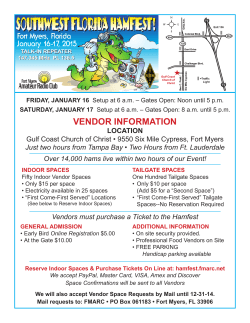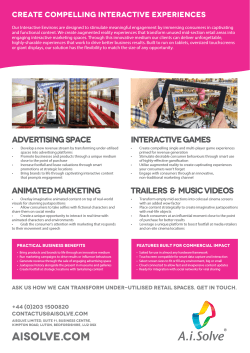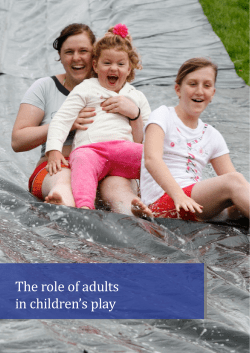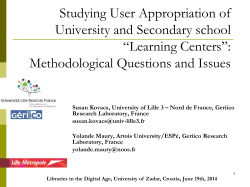
INNOVATION CENTER IDEABOOK
INNOVATION CENTER IDEABOOK Innovation is the driving force of today’s economy, more essential for business success than ever before and harder to achieve. A well-designed workplace has the power to propel an organization’s innovation potential, amplifying the performance of individuals, teams and entire enterprises. Understanding Innovation 04 Why Innovation? 07Trends 08 Key Tensions 10 Key Elements 12 Safe Haven for New Ideas 14 Culture of Innovation and Collaboration 16 7 Habits of Innovation 18 Local/Global Connectedness Designing for Innovation 22 Key Zones 24 Design Considerations 30Scalability + Customization 32 Innovation Center Floorplans 3 Understanding Innovation WHY INNOVATION? Innovation drives advancement. That’s always been true – throughout history, in every enterprise and in every part of the world. Today, however, the drive for innovation is more intense than ever before. Global competition, rising customer expectations and escalating complexity now make innovation a business imperative, impossible to ignore. Companies know they need to improve and reinvent continuously to stay competitive. And yet, innovation doesn’t come easily. It requires building an innovation culture and creating the right kind of environment where people and their ideas can thrive. 4 INNOVATION CENTER IDEABOOK UNDERSTANDING INNOVATION TRENDS Two notable workplace trends affect the process of innovation: Empowerment To do their best work, people want control over how they work. Having choices is empowering. It helps build an environment of trust, encouraging people to share ideas, take risks and make decisions – fundamental behaviors for creating innovation. Restoring boundaries Constantly connected to one another and surrounded by abundant, easily accessible information, workers today deal with workplaces full of distractions and noise. This threatens their productivity, creativity, decision-making, emotional wellbeing and willingness to engage with others – all key for effective innovation. Controlling the flow of information and level of stimulation has become critical. 7 UNDERSTANDING INNOVATION KEY TENSIONS PLANNING AND CREATING AN INNOVATION CENTER THAT SUPPORTS PEOPLE WORKING TOGETHER AND ADVANCES THE SPEED OF INNOVATION REQUIRES BALANCING A NUMBER OF NEEDS. Secure Support experimentation and protect fragile ideas. Self-serviced Provide basic provisions and amenities for teams to access on their own without disrupting their workflow. Static Create a sense of permanence with consistent tools, space and experience. Owned Assign settings exclusively to an individual or a team. 8 INNOVATION CENTER IDEABOOK Open Invite engagement within the community of innovators. Facilitated Facilitate and provide services to organize space and orchestrate interactions when teams require additional assistance. Evolving Embrace change as processes evolve over time; “always under construction.” Shared Create spaces for everyone’s use at different times. UNDERSTANDING INNOVATION KEY ELEMENTS FOR ANY ENTERPRISE THAT WANTS TO AMPLIFY ITS CAPACITY FOR INNOVATION, THREE ELEMENTS ARE KEY. SAFE HAVEN FOR NEW IDEAS In a protected “incubator” environment, teams are free to test and develop fragile ideas, accelerating iteration and innovation. 10 INNOVATION CENTER IDEABOOK CULTURE OF INNOVATION AND COLLABORATION Space can encourage curiosity, experimentation and collaboration. It can inspire new thinking and communicate key aspects of brand and culture. LOCAL/GLOBAL CONNECTEDNESS Co-located and distributed teams have distinct needs. Thoughtful integration of teams across distances requires planning, insight and commitment to minimize disparities. 11 UNDERSTANDING INNOVATION SAFE HAVEN FOR NEW IDEAS In a protected “incubator” environment, teams are free to test and develop fragile ideas, accelerating iteration and innovation. Create a nurturing environment • Provide areas for thinking alone and together, plus areas to build and test ideas. • Understand that messiness is often essential to the process. • Facilitate generative collaboration (i.e., combining content and knowledge to solve problems). • Support • Provide the flow of ideas, good and bad. a safe haven for generating, sharing and prototyping. • Support the rhythm of collaboration – breaking apart for individual work and then coming back together again. 12 INNOVATION CENTER IDEABOOK 13 UNDERSTANDING INNOVATION CULTURE OF INNOVATION AND COLLABORATION Space can encourage curiosity, experimentation and collaboration. It can inspire new thinking and communicate key aspects of brand and culture. Inspire curiosity • Reinforce openness, transparency and gaining inspiration from others’ work in progress. • Stage items that inspire. • Provide access to subject experts to disrupt conventional thinking and expose learning opportunities. • Make sharing social. • Create space for storytelling. Encourage experimentation • Create a set of permissions that empower people; move away from a “rules-based” approach. • Plan for serendipity; allow unplanned encounters to occur easily in the space. • Celebrate risk-taking, whatever the results. • Allow teams to own a space for the length of their project. Stimulate collaboration • Allow for the messiness of brainstorming. • Build diverse, interdisciplinary teams to solve problems in new ways. • Cultivate a vibe of enthusiasm and optimism. • Create spaces for different modes of collaboration: informative, evaluative and generative. 14 INNOVATION CENTER IDEABOOK 15 UNDERSTANDING INNOVATION 7 HABITS OF INNOVATION IN PREPARATION FOR THEIR MOVE INTO STEELCASE’S NEW INNOVATION CENTER, A CROSS-DISCIPLINE TEAM DEVELOPED A MANIFESTO OF SORTS FOR NEW RESIDENTS. THE AIM: ACCELERATING INSIGHTS TO INNOVATION. Raise central Be observers, Make ideas Share and Make others Be an Fail faster to questions listeners and visible co-create successful optimist succeed sooner learners Ask big questions, and then We are all explorers of ideas, Get ideas out of your head – Reach out to foster connec- A great measure of your Enthusiasm is contagious. Learn, rinse, repeat. Don’t start digging in. It can be in- and we need to uncover the make them visible! Write it, tions and meaningful rela- success is how well you We all share an innate opti- wait to try and get every- timidating to work in unchart- edges of what we already doodle it, hack it, build it, act tionships both inside and have made others success- mism in the very work that thing right the first time. Even ed territory without familiar know so that we’re able to it out, make a video, what- outside of the company. In- ful. Build an environment of we’re doing; our collective if something doesn’t work as paths to follow, or with no right step into new territories. So ever. Ideas are useful only to spiration, opportunities and trust and respect around efforts create solutions that expected, we still learn from or wrong answers. But accept roll up your sleeves, get dirty the extent that they can be partnerships can come from you. Recognize your col- can improve people’s lives it. Rapid prototypes gradu- this ambiguity as a part of your and take risks to venture shared, evaluated and built anywhere; they feed your leagues, their and build a healthier world. ally grow your understand- process and go with it. Ques- into the unknown! Covering on by others. If you have intellectual appetites and contributions and build on Openly embrace this enthusi- ing of the big problems that tion your assumptions and a lot of ground quickly will trouble finding a way to ex- assemble a more dynamic their ideas. Celebrate cour- asm, and listen to construc- we’re trying to solve, piece ask crazy, lofty questions ... help you uncover the most press or visualize your ideas, community. So, spark some age, and create more op- tive criticism – it makes ideas by piece. And the more then explore these mysteries exciting opportunities to take team up with someone who interesting and even provoc- portunities stronger, and doing so also things you try out, the more by breaking them down into further. can help you get your ideas ative discussions by inviting around you to shine. gets others excited about you learn – faster! out in the open. more diverse voices into your focused pursuits. encourage for the people what you’re creating together. conversations. Mix it up – great ideas can come from unexpected places. 16 INNOVATION CENTER IDEABOOK 17 UNDERSTANDING INNOVATION SHARED EXPERIENCE + PROCESS ACCESS TO TOOLS, TECHNOLOGY + SPACE LOCAL/GLOBAL CONNECTEDNESS To foster innovation between co-located and distributed teams, an organization must provide a consistent and equitable experience through access to tools, technology and space. Distributed teams However, co-located and distributed teams have distinct needs. Thoughtful integration of teams across distances requires planning, insight and commitment to minimize disparities. Acknowledge the need to solve for co-located and distributed teams in different ways. • Make interactions fluid by facilitating informal video Co-located teams • communication throughout the day and providing videoconferencing rooms for meetings. • • • • Provide technology that makes content-sharing easy for everyone. Increase opportunities to network, interact and build trust for stronger working relationships. Inspire new thinking with a venue for informal interactions, workshops and speakers. • Provide spatial flexibility with mobile furniture and Provide multiple monitors so participants can see assets that can be easily reconfigured to meet one another and shared content concurrently. worker needs. Create spatial context by providing similar environments in all locations. • Support movement during videoconferencing with technology that captures the entire setting. • Create a dashboard that communicates phases and status of work. 18 INNOVATION CENTER IDEABOOK 19 Designing for Innovation Key Zones Design Considerations Scalability + Customization Innovation Center Floorplans 21 KEY ZONES Resource center This inviting space promotes both intentional and chance The host for the Innovation Center supports the tools, encounters with coworkers. It supports social behaviors culture and processes that are necessary for innovation. around connecting with others to help foster a community This space houses the work tools and shared materials of innovation. that support the residents of the Innovation Center. Meeting commons Nomadic camp This space is designed for deep collaboration, supporting The nomadic camp invites individuals who are transitioning the cycle between individual and collaborative modes throughout the day between projects and tasks. Located throughout the duration of a project. Settings are planned close to the concierge, and with easy access to work purposefully to accommodate project needs over time, while tools that help workers manage their day, the space gives promoting connection across the table or across the globe. individuals everything they need to be productiv0e. Resident neighborhood Specialty zone Designed to grow expertise and community within their A specialty zone would be an area specific to the innovation discipline, the resident neighborhood supports workers who at hand. An example might be a prototyping area, machine are tethered to technology and have assigned spaces. shop, laboratory or resource library. MEETING COMMONS RESIDENT NEIGHBORHOOD DESIGNING FOR INNOVATION Social hub SOCIAL HUB NOMADIC CAMP RESOURCE CENTER SPECIALTY ZONE Space is the stage for the overall experience and, as such, it needs to work hard on all fronts: supporting the business processes, positively influencing the culture, and fully accommodating the appropriate technology and tools. An ecosystem of interdependent zones can increase team engagement in the innovation process and better support the key behaviors and habits of innovation. 22 INNOVATION CENTER IDEABOOK 23 ZONE: SOCIAL HUB ZONE: MEETING COMMONS This inviting space promotes both intentional and chance encounters with coworkers. It supports social behaviors around connecting with others to help foster a community of innovation. This space is designed for deep collaboration, supporting the cycle between individual and collaborative modes throughout the duration of a project. Settings are planned purposefully to accommodate project needs over time, while promoting connection across the table or across the globe. Design considerations • Leverage technology to organize and deliver company information, Socializing with others • creating an enterprise-wide link for employees. Relaxing to recharge • Create small collaborative and social settings to support planned Refueling with nourishment and unplanned interactions throughout the workday. Staying connected to organizational information • Create engaging experiences that attract workers to the space. • Leverage the space to strengthen relationships and build trust. • Provide informal settings where workers can unwind and rejuvenate. • Incorporate flexibility to hold events and host experts, ensuring that • • • 24 Tailor spaces for various worker needs (e.g., different tools and Presenting to others technologies, levels of formality, duration of use and postures). Generating new ideas Provide transition spaces that allow workers to prepare for or Connecting with other geographies debrief between meetings or to step aside during a meeting Co-creating with others to take a phone call or complete an individual task. Preparing for meetings Incorporate videoconferencing and technology to enable distributed collaboration for remote users. • the technology and furniture are scaled to the size of the group. Worker behaviors supported DESIGNING FOR INNOVATION Worker behaviors supported Design considerations Consider adjacencies of resident and nomadic spaces so people can quickly switch between individual and group work modes. Provide access to food and beverages throughout the workday. INNOVATION CENTER IDEABOOK 25 ZONE: RESIDENT NEIGHBORHOOD ZONE: NOMADIC CAMP Designed to grow expertise and community within their discipline, the resident neighborhood supports workers who are tethered to technology and have assigned spaces. The nomadic camp invites individuals who are transitioning throughout the day between projects and tasks. Located close to the concierge, and with easy access to work tools that help workers manage their day, the space gives individuals everything they need to be productive. Design considerations Worker behaviors supported Design considerations • spaces for planned and impromptu needs. Taking a moment to rejuvenate Support users’ work modes, personal preferences and Having a private conversation wellbeing needs by providing a variety of settings. Working alone among others Working on tasks • Carefully consider the blend of spaces for focused thinking (both Concentrating individually and as a team) and spaces for making prototypes. Absorbing information Provide alternative work settings, such as private enclaves, so Sharing ideas workers can choose where to work based on the task at hand. Connecting with others • Provide for the privacy experiences of focus and rejuvenation. Enable seamless transitions between work modes – focus, collaboration, Building relationships • Consider lockers for mobile workers to house belongings, long and short term. learning, social, rejuvenation – within the surrounding ecosystem of spaces. Working together • Plan for easy access to the meeting commons and social hub. • Incorporate intuitive tools and technologies for ease of use. Seeking respite • Consider adjacencies and protocols to create or manage • Consider “aside” and “porch” spaces where people can connect, share or get away. • Balance collaboration with spaces for rejuvenation where workers • can refresh, access nature or spend meaningful time alone. INNOVATION CENTER IDEABOOK DESIGNING FOR INNOVATION Focusing on a task Provide customizable assigned work settings for individuals in a co-located team. • 26 Provide a mix of reservable and on-demand individual • • Worker behaviors supported the intended vibe and stimulation of the space. • Incorporate collaborative spaces where teams can gather to share ideas and information quickly. 27 ZONE: RESOURCE CENTER ZONE: SPECIALTY ZONE The host for the Innovation Center supports the tools, culture and processes that are necessary for innovation. This space houses the work tools and shared materials that support the residents of the Innovation Center. A specialty zone would be an area specific to the innovation at hand. An example might be a prototyping area, machine shop, laboratory or resource library. Worker behaviors supported Design considerations • • Provide workspace for a host/concierge. Seeking assistance • Consider the entry/welcome experience for guests and residents, Accessing work amenities so they can connect to tools, spaces and people, as needed. Pursuing technology help and advice Enhance effectiveness by providing appropriate tools and technology esigning a personalized D meeting experience • on an as-needed basis. • Provide storage for work tools that support customized meeting experiences Understand the unique needs of the organization and the requirements of its development process. • DESIGNING FOR INNOVATION Design considerations Ensure easy access and adjacency to team work areas to support optimal workflows. • Provide a place for prototyping and testing ideas – virtually or physically. (mobile telepresence, whiteboards, presentation tools, etc.). • Provide appropriate self-serve and facilitated hosting services so team members can maintain optimal efficiency in their workflows. 28 INNOVATION CENTER IDEABOOK 29 SCALABILITY + CUSTOMIZATION INTERNAL MODELS OF INNOVATION The different zones within an Innovation Center create an ecosystem of OFF-SITE MODEL ON-SITE MODEL interdependent spaces that act as a platform for the innovation process. Each must be customized and scaled to the organization in alignment with its specific business needs and goals. Working together, the zones create an inspiring environment where innovators can come together in interdisciplinary teams to DESIGNING FOR INNOVATION create and advance innovation. Organizations seek innovation in a number of different ways, from internal grassroots efforts to external partnerships. Within this ideabook, we’ll be exploring two internal models: an off-site floorplan and an on-site floorplan. 30 INNOVATION CENTER IDEABOOK 31 INNOVATION CENTER FLOORPLANS The process of innovation is unique to each organization, so the space to support it should be unique, NOMADIC too. There are many ways to design for innovation in organizations with different needs related to location, CAMP MEETING COMMONS SOCIAL HUB RESOURCE CENTER RESIDENT NEIGHBORHOOD size and project type. Exploring these two examples of internal Innovation Centers – an off-site model and an on-site model – may help identify and visualize opportunities. SOCIAL HUB NOMADIC CAMP RESOURCE CENTER DESIGNING FOR INNOVATION MEETING COMMONS RESIDENT NEIGHBORHOOD 32 OFF-SITE ON-SITE SAMPLE SCENARIO: 11,500 SQUARE FEET SAMPLE SCENARIO: 20,000 SQUARE FEET INNOVATION CENTER IDEABOOK 33 INNOVATION CENTER OFF-SITE MODEL For some organizations, getting away is how innovation happens best. In this off-site model, a team can develop, prototype and validate innovation initiatives in a distinctly different, counterculture-like environment with the freedom to pursue distinct values and processes. The space supports small teams that repeatedly come together and disperse, accommodating DESIGNING FOR INNOVATION individual work within the cycle of collaboration. Design solution includes: • Ample videoconferencing for keeping in touch with headquarters or other on-campus sites • Hospitality for hosting visitors • A variety of meeting spaces to accommodate the varied needs of project teams as they move through the innovation and development processes • Nomadic spaces for mobile team members as they move in and out of the space • Small phone booths, enclaves and individual settings for spontaneous privacy needs 34 INNOVATION CENTER IDEABOOK 35 DESIGNING FOR INNOVATION ENTRY + RESOURCE CENTER A centrally located resource center supports all business needs. Here workers have selfservice access to necessary supplies and meeting tools. The entry sets the stage for a welcoming experience with a concierge to help introduce and orient workers to the space. 36 INNOVATION CENTER IDEABOOK Lockers help to host mobile users with secure storage and easy access to their belongings throughout the day. 37 DESIGNING FOR INNOVATION SOCIAL HUB The café acts as a crossroads, connecting the entry with the working space. Here workers gather, connect and gain nourishment. Providing a change of pace in this Innovation Center, the café acts as a place for individuals to connect with others, work individually or take a break from meetings in a social environment. 38 INNOVATION CENTER IDEABOOK Dyadic booths connect the café and nomadic camp and also support transitions throughout the space. This space allows workers to informally collaborate without removing themselves from the energy and activity of the café. 39 DESIGNING FOR INNOVATION NOMADIC CAMP This open library acts as a connection point between the nomadic camp and the meeting commons. Guests can use this space to quietly connect or individually decompress and focus. These collaborative settings support short-term group sessions and also provide spaces for breakouts from project rooms. Whiteboards and media:scape support brainstorming and content-sharing. 40 INNOVATION CENTER IDEABOOK Benches support workers with a place to touch down while transitioning between individual and collaborative work. This setting accommodates workers by offering light storage, easy access to power and technology. 41 DESIGNING FOR INNOVATION MEETING COMMONS Intimate in-between spaces provide places for workers to connect or step away during transitions throughout the day. This owned project space allows teams to be co-located for the duration of a project. The surroundings provide collaboration and brainstorming through amplification, whiteboards, storage for artifacts and a separate lounge zone. 42 INNOVATION CENTER IDEABOOK Project spaces equipped with mobile furniture allow teams to reconfigure the space to accommodate their needs. Space for hosting inside the room limits interruptions throughout an all-day working session. 43 DESIGNING FOR INNOVATION RESIDENT NEIGHBORHOOD The resident workstations are shielded and centrally located to ensure privacy and to support focused work, while remaining connected to the people and activity of the space. Heightadjustable benching provides workers with choices in posture within a setting optimized for connection to the team. These informal spaces support spontaneous connections and serendipitous interactions. Adjacency to the staff space also supports collaboration and impromptu planning with the resident team. 44 INNOVATION CENTER IDEABOOK 45 INNOVATION CENTER ON-SITE MODEL This model creates a safe haven for new ideas within the larger space of an organization’s campus. It’s designed to empower a distinct cross-functional group that is responsible for innovation within the organization. Highly secure, the space can be accessed only by designated employees who actively contribute to innovation and development processes. With DESIGNING FOR INNOVATION opportunities for individual work as well as group collaboration across distances, the space intentionally fosters a culture of innovation through creating, sharing and testing ideas. A range of settings provides for individual choices, and dedicated team spaces support key innovation behaviors. Design solution includes: • Individual spaces adjacent to and embedded in project studios for shifting from individual to group work • Small phone booths, enclaves and individual settings for spontaneous privacy needs • Front porch spaces for project studios to accommodate collaborative transitions • Anticipation of constant expansion and contraction of project studios as project teams and phases change over time 46 INNOVATION CENTER IDEABOOK 47 DESIGNING FOR INNOVATION ENTRY + RESOURCE CENTER As visitors enter the Innovation Center, a concierge welcomes them and helps them connect with the people, space and tools they need. The entry commons welcomes guests and helps them easily transition into the Innovation Center. The heritage wall displays organizational culture and values, which strengthens the culture within the space. 48 INNOVATION CENTER IDEABOOK The resource center provides access to storage lockers, mobile carts and work tools such as media:scape mobile, mobile whiteboards and various office supplies. 49 DESIGNING FOR INNOVATION SOCIAL HUB A centrally located café helps build a sense of organizational culture and belonging. Workers can connect, socialize and build valuable social capital. Semi-enclosed booths shield workers and provide a space for personal or casual conversations. Mobile media:scape offers the option of digital content-sharing. 50 INNOVATION CENTER IDEABOOK An outdoor extension of the social hub includes settings for workers to socialize and connect to nature. Outdoor options help extend the workspace, provide choice and promote wellbeing to create a productive work environment. 51 52 Groups can quickly immerse themselves here, hold a brainstorming session and easily rearrange the space to meet their needs. The front porch supports transitions before, during and after meetings. Also included in the porch area is a place to display and share team communications. The team studio allows a project team to generate analog and digital content. There is ample space to spread out, and videoconferencing provides a way to connect distributed teams easily. A project room provides a team with a dedicated, owned space for a period of time. Lockable storage, access to power and data, integrated technology, and display space aid the project in process. INNOVATION CENTER IDEABOOK DESIGNING FOR INNOVATION MEETING COMMONS 53 54 Height-adjustable tables give residents the ability to shift postures throughout the day. Power access, lighting, work tools and bag storage help maximize the work area. A shared, dynamic space provides a team with acoustical privacy from the rest of the office, with space for ideasharing and feedback, as well as social interaction – building a sense of community among team members. Workstations wrapped in full-height panels provide residents with boundary, ensuring privacy and helping define and separate the space. Each resident is provided with storage, technology support and work tools. The back porch of the team room provides individual spaces to make private phone calls, engage in focused work away from teams or simply unwind. INNOVATION CENTER IDEABOOK DESIGNING FOR INNOVATION RESIDENT NEIGHBORHOOD 55 56 This nomadic setting provides storage and defined boundaries for workers seeking focus. Private enclaves offer workers a high degree of control and boundaries for rejuvenation or shallow-focus work. Individual settings with high boundaries are provided for nomads who seek minimal interruption. Height-adjustable tables allow for movement and customization, ideal for longer durations. In this reservable workspace, a dyadic team can work side by side at a worksurface or in an alternativeposture lounge area that offers a comfortable place to share content or connect. INNOVATION CENTER IDEABOOK DESIGNING FOR INNOVATION NOMADIC CAMP 57 Steelcase Innovation Center 58 INNOVATION CENTER IDEABOOK 59 Call 800.333.9939 or visit Steelcase.com facebook.com/Steelcase twitter.com/Steelcase youtube.com/SteelcaseTV Item #15-0000134 3/15 ©2015 Steelcase Inc. All rights reserved. All specifications subject to change without notice. Trademarks used herein are the property of Steelcase Inc. or of their respective owners. Printed in U.S.A. FSC certified.
© Copyright 2025









